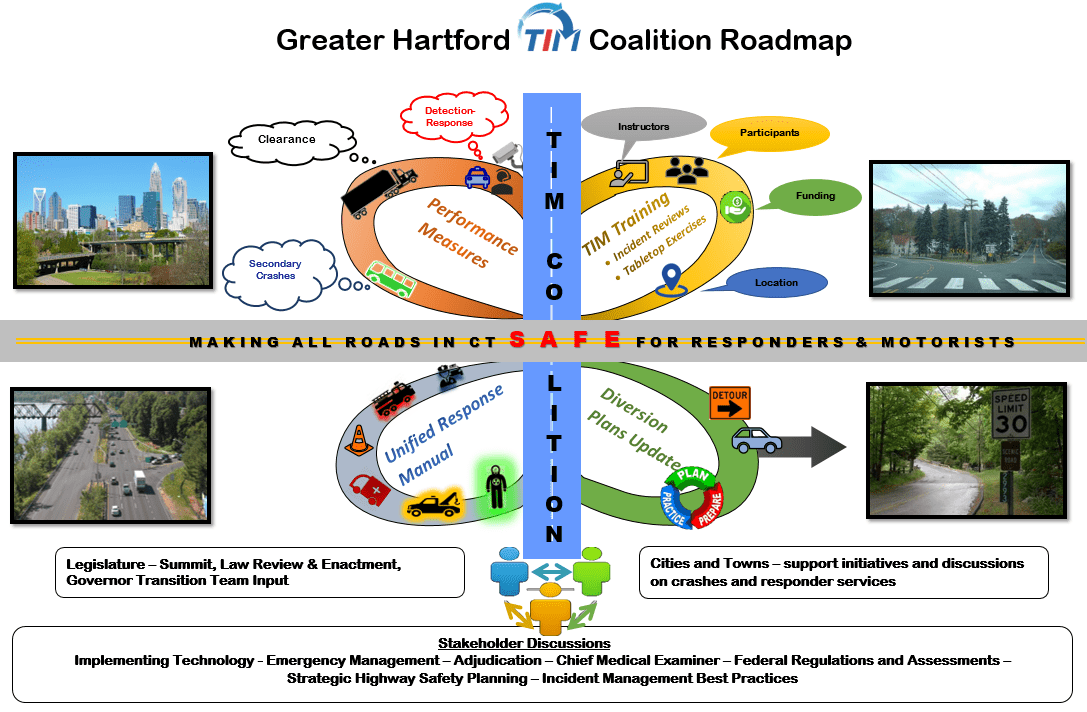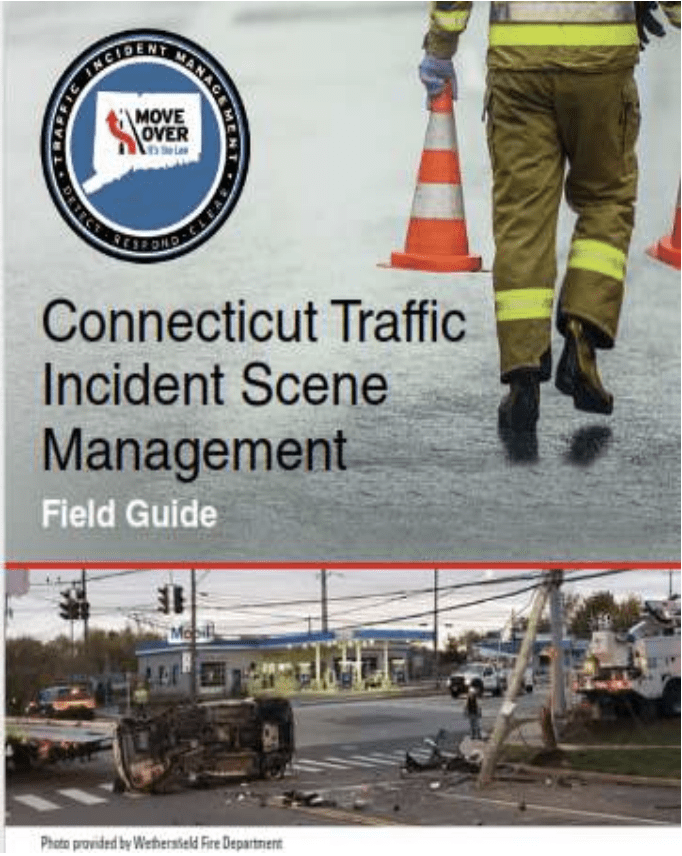OUR MISSION
To provide a systematic, planned, and coordinated multi-disciplinary approach to detect, respond and clear crashes to restore traffic capacity as safely and quickly as possible.
OUR VISION
To enhance motorist and responder safety during traffic emergencies by creating and sustaining partnerships with law enforcement, fire and emergency medical services, transportation and environmental agencies, towing and recovery, drivers, the media, the insurance industry and others.

Traffic Incident Management Committees Drive Roadway Safety
The Success of the Delaware Valley Regional Planning Commission Shows Why TIM Committees are So Valuable.
For a link to Greater Hartford TIM Coalition Activities click the button below.

IN THE NEWS
CONNECTICUT MOVE OVER LAW EXPANDED
Substitute Senate Bill No. 994, Public Act No. 23-40
Sec. 32. Section 14-283b of the general statutes is repealed and substitute language which includes the following additions and is effective October 1, 2023.
Added (b) (2)
(2) Any operator of a motor vehicle on a road that provides for two lanes of undivided traffic proceeding in the opposite direction when approaching one or more emergency vehicles that are stationary or traveling significantly below the posted speed limit and located on the shoulder, lane or breakdown lane of such road shall immediately reduce speed to a reasonable level below the posted speed limit until safely clear of the emergency vehicle.
Added “or any occupant” to (d) (1)
Any person who violates the provisions of subsection (b) of this section shall have committed an infraction, except that if such violation results in the injury of the operator or any occupant of an emergency vehicle, such person shall be fined not more than two thousand five hundred dollars and, if such violation results in the death of the operator or any occupant of an emergency vehicle, such person shall be fined not more than ten thousand dollars. (2) Any person who violates the provisions of subsection (c) of this section shall have committed an infraction.
The report was published December 2016. The purpose of this report is to present to the joint standing committees of the General Assembly, the current status and future plans of Connecticut Enhanced Accident Response Plan (EARP); as mandated by Section 164 of 2015 CT Public Act 15-5.
by Patrick Skahill | Connecticut Public June 12, 2023
In a matter of weeks, state officials have already mailed out nearly 1,000 warnings to drivers speeding through work zones across Connecticut. That’s according to preliminary data from the state Department of Transportation, which has launched an automated speed camera pilot program at pre-selected work zones. All camera locations are posted online and highlighted with signs on the road.
Connecticut already allows speed limit enforcement in highway work zones. A bill would allow municipalities to use them on roads to enforce speed limit and red light violations.
Automated Traffic Enforcement Safety Device Program
The purpose of the Automated Traffic Enforcement Safety Device (ATESD) Program is to empower Connecticut municipalities to improve roadway and pedestrian safety within their communities. ATESD capture images of drivers committing traffic violations, such as speeding and running through red lights. The objective of this program is to improve public safety, change driver behavior, and save lives.
Red-Light And Speed Safety Camera Guidelines For Connecticut Municipalities
The Vision Zero Council is an interagency work group tasked with developing statewide policy to eliminate transportation-related fatalities and severe injuries involving pedestrians, bicyclists, transit users, motorists, and passengers.
Vision Zero Council Proposals to C.G.A. (This document reflects the policy proposals submitted to the Connecticut General Assembly for consideration by the Vision Zero Council for the 2023 legislative session).
CONNECTICUT QUICK CLEARANCE LEGISLATION
These Connecticut General Statutes have direct relevance to TIM activities in support of quick clearance.
Authority Removal Law
CT General Statutes Section 14-66(g)
Move Over Law
CT General Statute Section 14-283b
Move-It Law
CT General Statute Section 4-224(d)
Nationwide, highway incidents, such as accidents, vehicle breakdowns and dropped debris, are responsible for 25% of all highway congestion. Pre-planned traffic incident management can result in a quicker response and a more rapid clearing of the incident. Personnel responding to an incident can operate in a safer, more efficient environment. CRCOG has helped address these issues on a regional and statewide basis since 1998. For more detailed information about each of these initiatives:
Regional Emergency Support Function 1 (Transportation) (Est. 2006)
The Regional ESF (RESF) facilitates communication and coordinates among regional jurisdictions and agencies concerning transportation issues and activities during a major disaster or incident. RESF-1 personnel focus on disruptions of the regional transportation system requiring inter-jurisdictional coordination and information sharing. Transportation disruptions can occur as a result of direct impacts upon the transportation infrastructure (e.g. disasters), major traffic incidents or from surges in requirements placed on the system by emergencies in other functional areas.
Statewide Incident Management Task Force (Est. 2003; No Longer Active)
In October 2003, the State Transportation Strategy Board endorsed the Incident Management Task Force White Paper and in November of that year, established a permanent Statewide Incident Management Task Force to address traffic incident management issues. The Transportation Strategy Board was not funded under 2011 State budget, but the group continues to meet on an ad hoc basis.
In 2006, the SIMTF obtained the services of IBI Group of Boston to assist in the writing of a Unified Response Manual for use in responding to incidents on the State’s highways. The final draft was presented to and adopted by the TSB in July 2008.
A training program for the URM is being developed.
In addition, a report on the status of the various proposals in the White Paper was presented to the TSB in July 2008.
The documents produced by the initial Task Force include:
The White Paper
A transmittal letter describing the recommendations concerning the permanent Task Force
Cost estimates for many of the 48 recommendations listed in the White Paper.
Status of Recommendations – 11/2010
July 2008:
Unified Response Manual Background - Report out by IBI Group July 9, 2018

TRAFFIC INCIDENT MANAGEMENT (TIM) TRAINING
A message from the Connecticut Department of Transportation TIM Coordinator, Aidan Neely.
"Since February 2022, the CTDOT TIM Team has provided the Federal Highway Administration Traffic Incident Management Responder Safety Training program to over 3,000 first responders across Connecticut. When it comes to TIM Training, the first responder community consists of personnel from the following agencies: Police, Fire, EMS, Public Works, Emergency Management, CTDOT, Public Safety Dispatchers, Tow Truck Operators, DEEP Haz-Mat Inspectors, DMV Inspectors, CT Dept of Consumer Protection Inspectors and OCME Investigators.
Our goal as a team for 2024 is to get this safety training to all first responders across Connecticut in our ongoing efforts to ensure the safety of all first responders as the TIM Training program applies to anyone who is exposed to traffic on any of the roadways or highways in our state in the course of their respective duties, roles and/or responsibilities.
There are a few items that I would like to share with you about the CTDOT TIM Training program.
- First of all, this training is completely FREE of charge to all first responders and agencies as the Federal Highway Administration funds this training program through CTDOT.
- All responders who attend the CTDOT/Federal Highway Administration TIM Training program and are currently certified as an EMR, EMT, Paramedic, etc, through Connecticut OEMS will receive six (6) CME Training hours towards their certification. We have been assigned a training code through CTOEMS to track this training.
- The CTDOT TIM Instructors are certified POST Instructors for all Connecticut POST Certified Police Officers who come through the training. Any POST Certified Police Officer who attends our TIM Training class will receive training credit hours which will comply with the newly enacted legislative mandate, under Public Act 22-132, requiring all POST Certified Police Officers to receive CTDOT/Federal Highway Administration TIM training.
- Each responder who completes the CTDOT TIM Training program will receive a training certificate documenting their completion of the training.
Should you be interested in this training opportunity, there are a couple of options available.
The first option is we can set up a TIM training class or classes to be conducted at a fire/police department or any facility used for classroom type training if you are interested in that. Our only request would be that we have a minimum of 20 class attendees for each class. This can be a mixture of personnel such has fire, police, EMS, public works, dispatchers, towing companies, emergency management, etc. The reason for this minimum class number is so that we can justify the training class cost to the Federal Highway Administration. We have provided TIM Training to several paid and volunteer fire departments across the state. Often, we have provided multiple days of TIM training at a fire department so that the department can get all their shifts through the program.
The second option is that you can send your personnel to one of the scheduled TIM classes that we have set up at CTDOT Headquarters on the Berlin Turnpike in Newington. I have attached a TIM Training flier identifying all the TIM Training classes that we are holding at CTDOT Headquarters through December 2024 should you wish send any personnel to see the class before hosting and to observe what the training program offers.
We are available to provide the TIM Training program Monday through Saturday and routinely begin the class at 8:30am and wrap up around 3:30pm. Those times include all class breaks and a lunch break."
Reach out to the CTDOT TIM Training Coordinator, Aidan Neely, aidan.neely@ct.gov or TIM Trainer, Rob Derry, rob.derryjr@arcadis.com anytime with any questions regarding the CTDOT TIM Training program.
CT DOT Traffic Incident Management Team: 2023 Executive Year-End Briefing
The report was provided by Aidan Neely, CT DOT Highway Operations Center Planner 3 and DOT T.I.M. Coordinator & CTIC Center Liaison
"As we bid farewell to 2023, I am delighted to share the remarkable achievements of the CT DOT Traffic Incident Management Team in our relentless pursuit of safety training and excellence.
This year, our team orchestrated an extensive training program, conducting 75 training sessions statewide and reaching a commendable 2,374 first responders. The impact of these efforts reverberated across various sectors: 302 police officers, 621 fire department members, 72 tow operators, 79 EMS professionals, 1,137 DOT/DPW personnel, and 163 individuals from other CERT teams and support agencies. This coupled with 2022’s classes make 103 program total trainings and a grand total of 3036 first responders."
The Greater Hartford TIM Coalition has developed a TIM field guide for scene management. It is currently being distributed to emergency responder organizations across the State.
A presentation to provide guide book information is available as well. Contact Terri Thompson at



